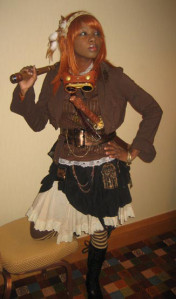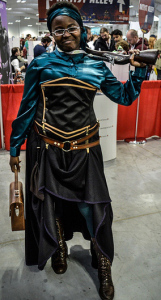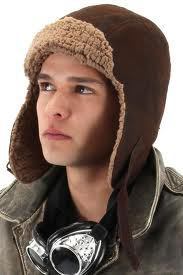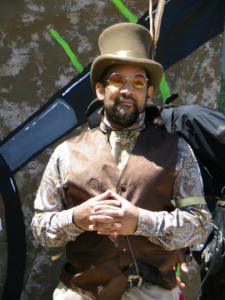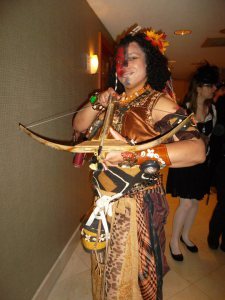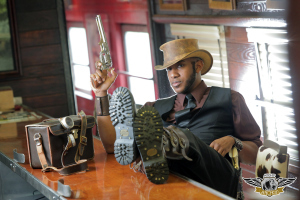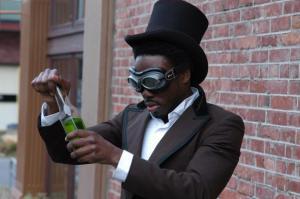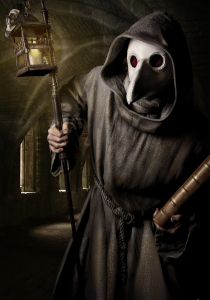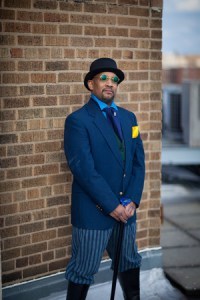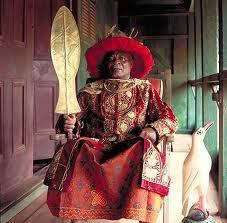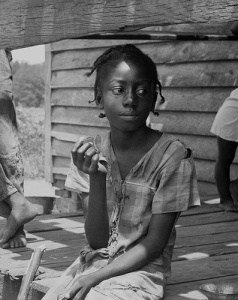Balogun Ojetade's Blog, page 11
October 28, 2015
THE BACKBONE OF A FAN CONVENTION: SOBSFic Con Calls For Volunteers
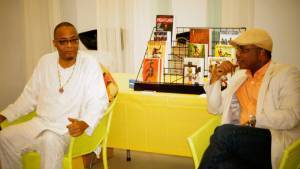 Working as a volunteer can involve hard work and require patience, but it is also a great way to build camaraderie and make new friends. It is also a lot of fun.
Working as a volunteer can involve hard work and require patience, but it is also a great way to build camaraderie and make new friends. It is also a lot of fun.
Volunteers must be available to help with the day-to-day operations of the convention as needed. They must be friendly, professional, patient and punctual.
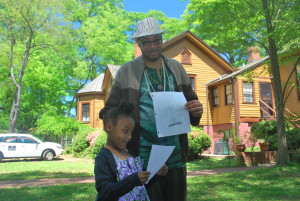 While volunteers might miss out on certain fan events, as they will be working during the Q&A sessions, photo ops, autograph sessions, panels, concerts and/or special events, all volunteers receive a free membership and may use the time spent as volunteer hours for any high school and college requirements.
While volunteers might miss out on certain fan events, as they will be working during the Q&A sessions, photo ops, autograph sessions, panels, concerts and/or special events, all volunteers receive a free membership and may use the time spent as volunteer hours for any high school and college requirements.
The following is a list of needed volunteer positions for SOBSFic Con. If you have any questions about volunteering, please contact our Director of Event Services, Akinbobola (“Akin”) Donaldson at akin.ropmovie@gmail.com.
Registration
Registration volunteers greet pre-registered members, search for them in the registration database and issue badges to con goers and Guests.
Operations
Operations volunteers serve as the eyes and ears of SOBSFic Con, wandering throughout the convention space, addressing situations as they arise and reporting back to the Director of Event Services. This job requires you to think on your feet, use good judgment, and exercise a sense of humor. You may be called on to do crowd control or assist with emergency situations but will spend much of the time walking, observing and interacting with congoers.
Panels and Other Programming
These volunteers reset rooms, ensure microphones are turned on, do brief surveys on panels, make sure panelists have water and mints and they generally keep things running smoothly.
Photography / Videography
Our videographers capture video content from various panels, events, and performances. Our photographers take pictures of congoers, volunteers, staff and Guests.
Social Media
These volunteers will act as roving reporters, using their smart phones, laptops or tablets to do live reporting of the panels and other goings-on at SOBSFic Con. This content will then be shared on the SOBSFic Con twitter account, State of Black Science Fiction 2012 Facebook Group andwherever else the volunteer chooses to share it and hype the convention.
Setup
These volunteers help put up the decorations and informational signs that will go up to convert the Southwest Arts Center into the SOBSFic Con Experience. Setup involves many different activities including assembling “swag bags,” putting up decorations and posters, setting up panel rooms, setting up the Awards show and Mahogany Masquerade and unloading supplies.
Tear-Down and Cleanup
These volunteers stay after the convention and help with the cleanup.
Hospitality
These volunteers will sit or stand and make sure people entering the Southwest Arts Center have a valid SOBSFic Con badge or know where to go to register. Hospitality volunteers needs to be polite and make everyone feel welcome.
Gaming
Game Masters, Story Tellers, Game Referees – whatever you want to call yourselves – if you are interested in running a session of Ki Khanga: The Sword and Soul Role-Playing Game and can make the gaming experience fun for everyone, this is the job for you!
Of course, we don’t just need people to run the games, but also to assist in the behind the scenes activities including hanging signs, giving directions, notating schedule changes as well as keeping track of time for Game Masters and Gamers.


October 22, 2015
It’s Official! SOBSFic Con gets a date and a home!
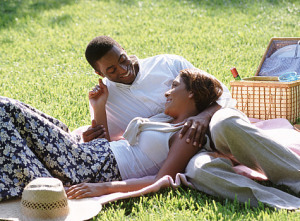 No, this is not the story of some con-man who meets a rich cougar, convinces her to have dinner at Spago and after that dinner, uses his charms to bed her, wed her and then move into her Beverly Hills mansion.
No, this is not the story of some con-man who meets a rich cougar, convinces her to have dinner at Spago and after that dinner, uses his charms to bed her, wed her and then move into her Beverly Hills mansion.
It ain’t that kind of con; it ain’t that kind of date; it ain’t that kind of home.
It’s way cooler than that!
The con I’m talking about is SOBSFic Con, the State of Black Science Fiction Convention, the long awaited family-friendly convention that brings together creators and fans of Black Speculative Fiction, Film, Cosplay and Comic Books and explores all of the genres through panels discussions, film screenings, gaming, workshops, masquerade balls and more.
The date is June 10-11, 2016.
 The home is the beautiful, Blacknificent Fulton County Southwest Arts Center in Atlanta, GA – the first facility built by Fulton County, GA solely for the arts. Located on a 27-acre campus in the quiet, upscale Cascade community, Southwest Arts Center features classroom space, a black box theater, a 375-seat auditorium and theater and the only fine art gallery in Southwest Fulton County.
The home is the beautiful, Blacknificent Fulton County Southwest Arts Center in Atlanta, GA – the first facility built by Fulton County, GA solely for the arts. Located on a 27-acre campus in the quiet, upscale Cascade community, Southwest Arts Center features classroom space, a black box theater, a 375-seat auditorium and theater and the only fine art gallery in Southwest Fulton County.
Now, you can ink in the date and prepare to walk, drive, fly, swim, dimension walk or teleport here.
We guarantee, it will be the best June 10-11, 2016 of your life!
Check back here – or at the official website – often for updates and more exciting news about #SOBSFicCon!


October 6, 2015
PUTTING THE FUNK IN STEAMPUNK: For the Mahogany Masquerade and Beyond!
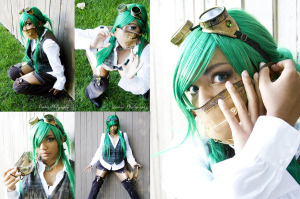 Dressing Steamfunk can be fun, but it can also be frustrating without first having a concept of who the character you want to portray really is.
Dressing Steamfunk can be fun, but it can also be frustrating without first having a concept of who the character you want to portray really is.
Steamfunk characters can be broken down into a few basic archetypes. Choose your character’s archetype and then develop a persona based on that archetype and create your persona’s back-story. This will help you determine what he or she should wear and make picking a costume much easier and more enjoyable.
My persona is Ogunlana, a Hunter / Fighter. He is the Aare Ona Kakanfo (“War Chief of War Chiefs”) of the Oyo Empire, who brought down an invading British airship with his war-drum, which emits powerful and destructive sonic waves. Ogunlana wears the trappings of the crew of the downed airship with his traditional African clothing to warn others what will befall them if they dare invade his homeland.
Here are a few archetypes. I have included suggestions for what they can wear. Add to or take away from them as you will, but most of all, make them your own…and make them funky!
Air Pirate: One of the quintessential Steampunk characters. Air pirates are bad, bold, and armed to the teeth.
An Air Pirate can look scruffy, or he or she can be a dashing and daring swashbuckler-type.
Gear for an Air Pirate could include, but is not limited to, a tricorn hat, corsair boots, tailcoat, ruffled shirt, brushed cotton trousers, a telescope, eye-patch, cutlass, blunderbuss and neckerchief.
Adventurer/Explorer: Their reason for being is to boldly go where no one has gone before; to experience new things; and to discover new places.
Dressed for the wild and unknown, Adventurers / Explorers should wear utilitarian clothing, with sturdy footwear, equipment, such as a compass, map and wineskin, goggles and perhaps a safari vest and a pith helmet. Khaki is a great material for them and jodhpurs (horse riding tights) also work well. Accent your look with leather – add a leather belt, pouches, holster (and revolver) and other leather accessories.
Aviator: Whether military, or a rogue; whether they’re flying a bi-plane, a zeppelin, or a space ship; they are tough, brave, and even a bit gallant, especially in contrast to Air Pirates.
A pilot would wear goggles, a flight helmet, and sturdy boots, and would most likely have a military bearing, or the personality of a rogue, depending on your preference.
Dandy/Femme Fatale: They use their wiles and charms to get what they want, sometimes at the expense of others.
Dandies / Femme Fatales wear very stylish, well tailored and flattering clothing. Suits, or a formal tuxedo or gown and well chosen accessories are the norm. Form-fitting and slightly revealing clothing in rich fabrics, rakishly worn hats, and bits of lace also work well.
Hunter/Fighter: Monster hunters are all about firepower and skill in combat. They stay armed with stakes, silver bullets, and strange, arcane-looking weaponry.
The Hunter / Fighter will be a walking arsenal. The chosen weaponry would depend on its prey. Monster hunters would be armed with stakes, silver bullets and arcane-looking weaponry. They would wear leather or canvas clothing and accessories. The western look would fit this archetype well.
Mad Scientist/Inventor: Another quintessential Steampunk character, they embody the steam in steampunk, discovering new things, solving problems, and occasionally blowing things up.
Goggles and other tools of the trade, such as work gloves, practical clothing (so pants would be appropriate for women), a lab coat, tool belts, tools and light weaponry should be worn and wondrous inventions carried.
Mechanic/Tinkerer: A bit of a twist on the Scientist/Inventor. Where the Inventor is creating things from scratch, the tinkerer is improving on things, often on the fly, or perhaps just trying to get things to work; making do with what they have.
Your dress is similar to the Mad Scientist / Inventor, above, however, eliminate the work gloves and replace the lab coat with a grease-stained, leather apron. Don’t forget to add a few smudges of grease and/or dirt to the face and hands.
Philosopher/Scholar: They like old, rare books and wax poetic about the classics; they talk too much about things no one cares about or prefer books to people.
A philosopher or scholar would most likely wear a man’s or woman’s two-piece suit (the woman’s suit would replace trousers with an ankle-length skirt), a woman’s boater hat or a top-hat, a blouse or shirt, dress boots, a floppy tie and spectacles or a monacle.
Socialite/Lady/Gentleman: Often based on Victorian aristocracy, they can often embody the refinement and social norms we associate with the upper class of that era. Many times they serve as patrons for the scholars, adventurers, and inventors.
Socialites would dress in a more sophisticated manner, with rich colors and materials. They would be well accessorized with gloves, parasols, or a cane, and a nice hat. For women, corsets worn on the outside and short skirts are also appropriate.
Street Sparrow/Scrappy Survivor: These are the street urchins, your pickpockets and beggars. This archetype also includes runaway slaves. Hungry and dirty, they do what they need to do to survive.
Wear soiled, tattered clothing and scuffed shoes. Add a bit of dirt to your face and wear your hair disheveled. If you rock an afro, braid it the night before you cosplay and then unbraid it when you are in costume for a wild, unkempt look.
Reformer: They could be abolitionists, suffragettes or an activist seeking to get rid of child labor or protesting imperialism. Reformers work to make the world a better place, often loudly and not always peacefully or without scandal.
Women could wear a suit, a hat, granny boots and maybe carry a derringer, tucked away somewhere in her suit.
Suggested wear for men includes an overcoat, waistcoat, John Bull top-hat, brushed cotton trousers, an ascot, a dress shirt and boots.


September 30, 2015
A Tribute to Science Fiction and Fantasy Icon, James Earl Jones!
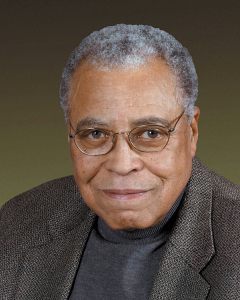 In today’s blog , I am paying tribute to science fiction and fantasy icon, James Earl Jones!
In today’s blog , I am paying tribute to science fiction and fantasy icon, James Earl Jones!
Most of you know of Mr. Jones’ acclaimed work as the iconic, menacing voice of Darth Vader in the mega-blockbuster Star Wars films (for which he was paid just $9000.00 for Star Wars Episode 4), however, you might not know that James Earl Jones began his nearly fifty-year film career in a Science Fiction movie and has acted in nearly forty science fiction and fantasy movies, television shows and video games.
I will talk about those in just a second, but I would like to first tell you about my meeting and “conversation” with this incredible actor and great person.
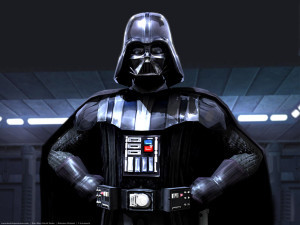 I was living in Chicago at the time. I had just left a downtown Thai restaurant and was walking off the delicious panang tofu and tom yum goon when I noticed that one of the streets was cut off and a film was being shot. Having worked on a few sets myself and aspiring to write and direct films, I decided to take a closer look.
I was living in Chicago at the time. I had just left a downtown Thai restaurant and was walking off the delicious panang tofu and tom yum goon when I noticed that one of the streets was cut off and a film was being shot. Having worked on a few sets myself and aspiring to write and direct films, I decided to take a closer look.
It so happens that two of the guys working security were friends I played paintball wargames with every weekend. They let me in and told me that James Earl Jones – one of my favorite actors – was shooting a film called A Family Thing. I was excited, to say the least, and one of my friends walked me over to the director – Richard Pearce – during a break in shooting and told him that I was a fan of James Earl Jones, an aspiring screenwriter and director and that I had done executive protection for several celebrities on a few films.
Mr. Pearce took me by the wrist and said “Come with me.”
I complied.
He walked me over to James Earl Jones and Robert Duvall – another stellar actor – and introduced me, telling Mr. Jones I was an admirer of his work.
Mr. Jones signaled me to come over. He held out his hands and I took them in mine and he just smiled warmly, not saying a word. He looked toward Mr. Pearce, who leaned in close, almost pressing his ear to Mr. Jones’ lips and Mr. Jones whispered a few words.
Mr. Pearce turned to me and said “James wants you to know that he has been crippled by stuttering all his life, but he wants you to hold his hand and feel the love and appreciation he has for you.” And I did. I stood there, feeling the kindness of this brilliant, talented man I admired so much.
He looked to Richard Pearce again and whispered to him once more. Mr. Pearce paused for a second, swallowed hard and said: “Mr. Jones says that ‘one of the hardest things in life is having words in your heart that you can’t utter’, but he hopes you really do feel what he is trying to say. With that tears began to flow down my cheeks. Mr. Pearce wiped the tears from his eyes and even Robert Duvall’s eyes welled with tears. With that, I choked out “Thank you. You just made my year.” And I hugged Mr. Jones. I then shook Robert Duvall’s and Robert Pearce’s hands and then departed, telling my friends that I sincerely owed them a HUGE favor for the hookup.
After that meeting, I was so inspired, I began to write screenplays again and I have told this story to nearly everyone I know. I thank James Earl Jones for that moment and will never forget it.
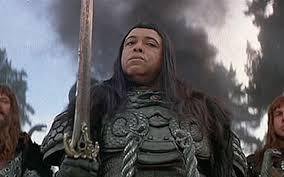 Why do I call James Earl Jones an icon of science fiction and fantasy (even horror)? Well, as I said at the beginning of this blog, his first film role was in the genre of science fiction. Ever heard of Dr. Strangelove or: How I Learned to Stop Worrying and Love the Bomb? He plays Lt. Lothar Zogg – a B-52 Bombardier – in the 1964 film.
Why do I call James Earl Jones an icon of science fiction and fantasy (even horror)? Well, as I said at the beginning of this blog, his first film role was in the genre of science fiction. Ever heard of Dr. Strangelove or: How I Learned to Stop Worrying and Love the Bomb? He plays Lt. Lothar Zogg – a B-52 Bombardier – in the 1964 film.
Of course, the Star Wars movies added tremendously to his iconic status as did his portrayal of the villain Thulsa Doom in the 1982 film, Conan the Barbarian.
Mr. Jones has also donated his acting talents to the following science fiction, horror and fantasy works:
The UFO Incident (1975 TV-movie)
Swashbuckler (1976)
Exorcist II: The Heretic (1977)
The Bushido Blade (1981)
The Flight of Dragons (1982) (voice)
Faerie Tale Theatre “Aladdin and His Wonderful Lamp” (1984)
Allan Quatermain and the Lost City of Gold (1987)
Pinocchio and the Emperor of the Night (1987) (voice)
Terrorgram (1988) (voice)
Best of the Best (1989)
Grim Prairie Tales (1990)
Ramayana: The Legend of Prince Rama (1992)
The Meteor Man (1993)
The Lion King (1994) (voice)
Judge Dredd (1995)
Stargate SG-1 (1997) (voice)
Merlin (1998) (voice)
The Lion King II: Simba’s Pride (1998 Direct-to-video) (voice)
Fantasia 2000 (1999)
Robots (2005) (voice)
Star Wars Episode III: Revenge of the Sith (2005) (voice)
Quantum Quest: A Cassini Space Odyssey (2009) (voice)
Jack and the Beanstalk (2010) (voice)
Much respect, James Earl Jones. If you ever read this, I pray you smile and feel what I am trying to say.


September 29, 2015
Black Pirates, Patriots and Pioneers: The Rococoa Anthology TOC
 It began as a call for stories for an anthology that would introduce the genre of Rococoa – the bridge between Sword & Soul and Steamfunk – to the world in a BIG way.
It began as a call for stories for an anthology that would introduce the genre of Rococoa – the bridge between Sword & Soul and Steamfunk – to the world in a BIG way.
Months later, I am happy – and proud – to announce the TOC for the Rococoa anthology!
The stories and the authors are equally amazing. Fans of science fiction, fantasy, action, adventure, Steampunk, Steamfunk, Sword and Soul and Black History alike are going to love this book!
Here is the TOC:
March of the Black Brigade – Balogun Ojetade
Cane – Milton Davis
The Adventure of the Silver Skull – Deanna Baran
The Adventures of the Black Star – Jeff Carroll
The Crafters’ Cove – D.L. Smith-Lee
Fool’s Errand – Gerald L. Coleman
Fury – Zig Zag Claybourne
Mkono ya Mbao – Steven Workman
Sea-Walker – Carole McDonnell
Seven Thieves – Emmalia Harrington
The Bandit King and the Island Of Tears – S.A. Cosby
Traveler’s Song: A Pulse Prelude – Kai Leakes
Bloodline – D K Gaston

Art by Toni Justamante Jacobs


September 24, 2015
A Sword and Soul Brother crashes the party at Con-Volution 2015!
Con-Volution is an annual 3-day science fiction, fantasy, and media convention featuring guests, performers and vendors from a wide spectrum of the speculative fiction industry and community. Each year’s event is presented within the framework of a different central theme from which most of its programming items evolve.
 Con-Volution provides a forum for creative professionals – writers, producers, artists, costumers, performers, game designers and editors – to network, entertain, educate, market their creations, and enjoy the company of people who love their works. For amateur creators and everyday fans, the event presents an opportunity to develop new skills, mingle with and listen to many of the professionals they admire, and to revel in the fellowship of the speculative fiction community.
Con-Volution provides a forum for creative professionals – writers, producers, artists, costumers, performers, game designers and editors – to network, entertain, educate, market their creations, and enjoy the company of people who love their works. For amateur creators and everyday fans, the event presents an opportunity to develop new skills, mingle with and listen to many of the professionals they admire, and to revel in the fellowship of the speculative fiction community.
A variety of games and tournaments are open to attendees, including collectible card games, live-action roleplaying and video games. The Gallery and Marketplace provide original themed artwork and a wide array of shopping items. Fan groups and other events similar to Con-Volution are represented at information tables and themed parties.
 Con-Volution’s staff is comprised of everyday members of the community, who volunteer their time to present an event where fellow fans can gather to enjoy, discover, discuss and debate all aspects of speculative fiction (sci-fi, fantasy, horror, comics, etc.). Con-Volution also performs outreach to those who enjoy speculative fiction films, television, literature and games but don’t think of themselves as “sci-fi fans,” or who are unaware that a fellowship of people like them exists.
Con-Volution’s staff is comprised of everyday members of the community, who volunteer their time to present an event where fellow fans can gather to enjoy, discover, discuss and debate all aspects of speculative fiction (sci-fi, fantasy, horror, comics, etc.). Con-Volution also performs outreach to those who enjoy speculative fiction films, television, literature and games but don’t think of themselves as “sci-fi fans,” or who are unaware that a fellowship of people like them exists.
This year, I am a Guest of Honor.
Below is my schedule. If you’re in Northern Cali October 2-4, stop by and say “hello.”
Dork Forest Podcast – Balogun Interview – Toastmistress Jackie Kashian’s “The Dork Forest” interviews Guest of Honor Balogun Ojetade.
Friday October 2nd 2015 @ 6:30 PM – Harbor A: 75 mins
Cultural Appreciation or Appropriation – Where is the line between enjoyment of other cultures being respectful and being detrimental? Gregg Castro, Moderator with panelists, Thaddeus Howze, Rob Miles, Balogun Ojetade and Heidi Stauffer
Friday October 2nd 2015 @ 11:00 PM – Sumac: 75 mins
Diversity in Speculative Fiction – Beyond the strapping nordic hero in his American flag draped spaceship lies a world of other cultures and other visions of the future. Come find out what they are. Gregg Castro, Moderator, with panelists, Jaymee Goh, Thaddeus Howze, Bradford Lyau, Balogun Ojetade, Sumiko Saulson
Saturday October 3rd 2015 @ 5:30 PM – SandPebble B: 75 mins
Writing for and with minority groups in mind – Every audience has a different focus. What are the best methods of reaching minority groups with your work?
Thaddeus Howze, Moderator with panelists, Marisa Garcia, Kyle Aisteach, Balogun Ojetade, Bryan Thao Worra
Sunday October 4th 2015 @ 2:30 PM – SandPebble B : 75 mins
Mythologies: The World Outside of Olympus and Asgard – There’s a great big world of mythology out there. Come find out what you might be missing!
Bret Sweet, Moderator with panelists, Emily Jiang, Balogun Ojetade, Jason Malcolm Stewart
Sunday October 4th 2015 @ 4:00 PM – SandPebble B: 75 mins
Writers Workshop: Writing Fight Scenes That Aren’t Wack – A Master Class with Guest of Honor Balogun Ojetade. *Limited to 6 participants.
Register at: http://con-volution.com/2015/conventi...
Sunday October 4th 2015 @ 5:30 PM – Oak : 75 mins


September 23, 2015
SUFFERING IN SILENCE: Nerds, Blerds and other Victims of Bullying in the Black Community
 The death of a 7 year-old boy from Detroit, who is believed to have hanged himself in mid-May, 2012, because he faced bullying at school and the separation of his parents, should have been a wake-up call to all families and communities.
The death of a 7 year-old boy from Detroit, who is believed to have hanged himself in mid-May, 2012, because he faced bullying at school and the separation of his parents, should have been a wake-up call to all families and communities.
This tragedy should have prompted people of Afrikan descent to dispel the myths about the need for counseling and mental health when a child is troubled and of course, the need for more of us to pursue careers in the field of mental health.
But it didn’t.
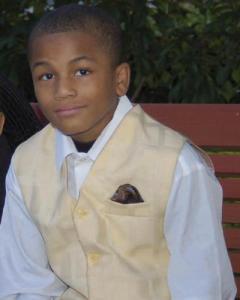 Last year, in September, family and friends of Lamar Hawkins III gathered to honor the life of the 14 year-old who committed suicide in his school’s bathroom after suffering bullying for months, from boys AND girls.
Last year, in September, family and friends of Lamar Hawkins III gathered to honor the life of the 14 year-old who committed suicide in his school’s bathroom after suffering bullying for months, from boys AND girls.
Hawkins attended Greenwood Lakes Middle School in Lake Mary, Florida.
The family had recently moved to Sanford, Florida from New York to raise their children in a safer environment after Lamar Hawkins III suffered bullying there, as well.
On the day of the shooting, Lamar’s mother, Shaniqua Hawkins, went to pick up her son from the school at approximately 5:00 p.m. but he was nowhere to be found. He was reported missing two hours later and after deputies searched nearby neighborhoods, he was found dead from a self-inflicted gunshot wound inside a bathroom stall inside of the school.
Our children need to know that they are loved. They need to know that they are important. This is not an indictment of anyone, but someone along the way failed these children.
These children felt hopelessness and helplessness. They decided that death was better than life. They were not crazy. They were in despair and we could have saved them.
But we didn’t.
They suffered in silence, as often we do.
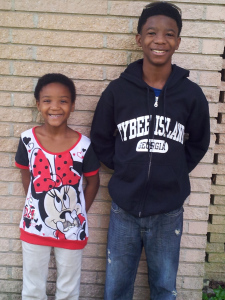 The 7 year-old boy, who the press refused to name, reminds me of my son, Oluade for a few reasons: 1) because he was the only boy in the home with eight girls and women, just as Oluade is – he has 7 sisters and his mother – and 2) because Oluade was also bullied.
The 7 year-old boy, who the press refused to name, reminds me of my son, Oluade for a few reasons: 1) because he was the only boy in the home with eight girls and women, just as Oluade is – he has 7 sisters and his mother – and 2) because Oluade was also bullied.
Unlike the 7 year-old, however, Oluade, thankfully, still lives. The 7 year-old, on the other hand, was discovered by his 14-year-old sister, hanging from a bunk bed with a belt around his neck.
While the bullying is said to have occurred at school, psychologists say teachers and administrators usually are the last ones to know if a child is being bullied.
A child’s peers will know if he or she is being bullied, but teachers are usually blind to the suffering of the children in their care.
I say blind because children who are troubled by bullying and other pressures at school show signs. Teachers just don’t – or won’t – see them. A bullied child may display regressive behaviors; they become withdrawn.
When we parents notice unusual behavior in our children, we should talk to them, show them love and, more often than not, we should seek some outside help and support – from respected elders in your family and community, from mental health experts, from spiritual leaders and / or support groups.
It is not an indictment of your parenting skills to seek resources to help your child.
Bullying is an increasing problem for children in Black communities throughout the U.S., but there are not a lot of statistics that reflect that. Most of the statistics point to problems in white, suburban communities.
In the Black community, many services our children need are cut. Schools have counselors, but if a school counselor has 300 or 400 students on his or her case load, they aren’t able to serve any of the children properly.
Here are some of the warning signs parents should watch for in their children:
Signs of depression such as ongoing sadness, withdrawal from others, losing interest in favorite activities, or trouble sleeping or eating – experts define depression as a negative view of self; a negative view of the world; and a negative view of the future.
Talking about, or showing an interest in, death or dying.
Engaging in dangerous or harmful activities, including reckless behavior, substance abuse or self-injury.
Giving away favorite possessions and saying goodbye to people.
Saying or expressing that they cannot handle things anymore.
Making comments about things being better without them.
To some people, it is unbelievable that black children bully other black children. One brother told me “Black children don’t bully; we thug.”
Well, the word “thug” originates in India. It was a term used to describe a ruffian and assassin. Today “thug”is a nominally polite way of non-Afrikans saying “nigger.”
When someone other than people of Afrikan descent talks about thugs ruining a place, it is almost impossible today that they are referring to somebody with blond hair and blue eyes. It is a sly way of saying “there go those niggers ruining things again.”
Thug, in the Black community, for about the past 25 to 30 years, has also meant ruffian or violent criminal, but being a ruffian is displaying a healthy sort of countercultural initiative, displaying a kind of resilience in the face of racism and oppression.
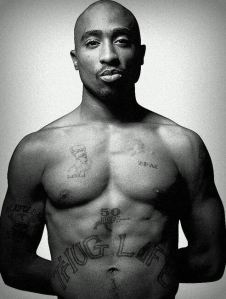 The word thug made a major change with the rise in popularity and cultural influence of Tupac Shakur, who had Thug Life tattooed across his stomach. Tupac Shakur is thought of as a god by many people. If he was a thug, then clearly if an Afrikan says “thugs were messing up the neighborhood,” then we mean something other than reprehensible.
The word thug made a major change with the rise in popularity and cultural influence of Tupac Shakur, who had Thug Life tattooed across his stomach. Tupac Shakur is thought of as a god by many people. If he was a thug, then clearly if an Afrikan says “thugs were messing up the neighborhood,” then we mean something other than reprehensible.
But bullying is reprehensible.
When a Black child makes straight A’s, comes to school on time, speaks in complete sentences, chooses a salad over McDonald’s, says “excuse me,” “please” and “thank you,” wears his pants up and talks about going to college or owning a business or being a CEO and is told they are acting white and then teased or even beaten up for it, he or she has been bullied – and that bullying is reprehensible.
Why? Because the bullied child changes with the hope that the bullying will stop. The grades slip from straight A’s to B’s, C’s and even F’s. The speech slips from speaking in complete sentences to calling his father “bruh” and his mother “shawty.” The clothing changes from neat to pants hanging down and the hair goes uncombed. They either drop out of school or finish at the bottom of the class – all done to stop the targeting and to fit in.
I know this to be fact. I am talking about my own son – other than dropping out, which he probably would have done had he been 16 instead of 11 or 12. And he wasn’t considered acting too white, but too Afrikan.
Did Oluade report to the school about his harassment?
Yes, he did. But it was ignored. It was not a big deal until Oluade fought back and someone other than my son got hurt, the fight ended up on Instagram and the school was embarrassed.
But the bullying didn’t stop. I removed Oluade from the school after students stole his new hat, new coat and backpack from his locker, urinated in his hat and spread the contents of his backpack all over the school. The coat was never recovered.
Urinating in his hat was an act of sexual violence and my gut told me the violence would escalate until either Oluade or one or more of the bullies were dead.
The poor monitoring of students and lackadaisical approach to bullying in public – and private – schools has to change in order to protect our children. Parents, teachers and other staff need to be taught that bullying is not acceptable and consequences must be put in place for such behavior.
Oluade’s plight and the plight of other children, teens and adults who continue to suffer physically and mentally because of bullying inspired me to write The Young Afrikan Warriors’ Guide to Defeating Bullies and Trolls. Within, you will find solutions to the problem of bullying and ways for the victims of bullying – and the bullies – to heal.
What are your experiences with bullying – as victim, parent, teacher, or bully? I invite and encourage your feedback.


September 21, 2015
Black Books on Beating Bullies
What is bullying?
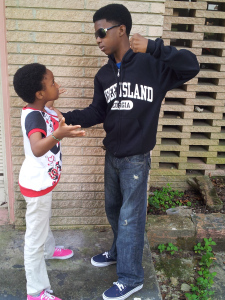 Television and the movies give us images of a big, strong, dumb intimidating boy beating up his smaller, brilliant classmate or of a popular group of boys – usually from the same athletic team at the school – shoving a nerd into a hallway locker and locking him inside it.
Television and the movies give us images of a big, strong, dumb intimidating boy beating up his smaller, brilliant classmate or of a popular group of boys – usually from the same athletic team at the school – shoving a nerd into a hallway locker and locking him inside it.
While those things do happen – and are, indeed, bullying – bullying behaviors can be much more complex and varied than those stereotypes.
For example, while some bullying is physical and easy to recognize, bullying can also occur quietly and covertly, through gossip or on a smart phone or the internet, causing emotional damage.
An act is defined as bullying when:
The behavior hurts, humiliates, or harms another person physically or emotionally.
Those targeted by the behavior have difficulty stopping the action directed at them, and struggle to defend themselves.
There is also a real or perceived “imbalance of power,” in which the student with the bullying behavior has more “power,” – either physically, socially, or emotionally – such as a higher social status, or is physically larger or emotionally intimidating.
The bullying behavior is repetitive. However, bullying can occur in a single incident if that incident is either very severe or arises from a pattern of behavior.
The behavior can be overt and direct, with physical behaviors, such as fighting, hitting or name calling, or it can be covert, with emotional-social interactions, such as gossiping or leaving someone out of an activity on purpose. Bullying occurs in-person, online or through smart phones and texts.
The Impact of Bullying
 Bullying was once considered a simple, harmless childhood rite of passage, but research shows that bullying has significant short and long-term effects that impact education, health and safety.
Bullying was once considered a simple, harmless childhood rite of passage, but research shows that bullying has significant short and long-term effects that impact education, health and safety.
While many books on bullying have been written for parents, teachers and children of all ages, only two have been written specifically for children of Afrikan descent. Much more needs to be written as it is a proven fact that people of Afrikan descent suffer more bullying than any other ethnic group – hell, most of us in the Diaspora are where we are because bullies took our ancestors and enslaved them in faraway lands (and the bullying continues) – and suffer more long-lasting psychological effects because we view being victimized as being a punk, chump or rooty-poot scrub, so we keep quiet about it, have no outlet for the pain and suffering and the stress manifests as strokes, heart attacks, depression, violent behavior, anxiety and loathing of self, culture and community.
The aforementioned two books designed specifically for the education, enlightenment and healing of Black people throughout the world who have suffered bullying are Bomani’s Stand, by Angela Freeman and The Young Afrikan Warriors’ Guide to Defeating Bullies and Trolls, by Balogun Ojetade.
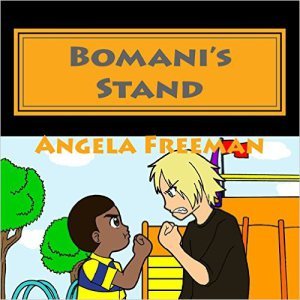 When a bully begins to create mischief in the neighborhood, Bomani has to make a choice. Will he be a coward or a warrior? Bomani’s Stand is the latest book in the “Nilajah’s Series”. This book teaches important lessons in manhood that both boys and girls enjoy and benefit from.
When a bully begins to create mischief in the neighborhood, Bomani has to make a choice. Will he be a coward or a warrior? Bomani’s Stand is the latest book in the “Nilajah’s Series”. This book teaches important lessons in manhood that both boys and girls enjoy and benefit from.
Angela Freeman’s “Nilajah Series” is centered on the dynamics of loving Black families. By exploring the relationship between family members, many topics facing the Black community are addressed in age-appropriate ways. This series is designed to combat the degeneracy and myths of inferiority that Black children are inundated with daily through mainstream media outlets.
As with all Angela Freeman Books, this is made for adults and children to read together. Doing so encourages dialogue between the generations. Children tend to ask many questions during and after reading this book. Make the most of their questions by encouraging them to think critically to find answers. Enjoy!
The Young Afrikan Warriors’ Guide to Defeating Bullies and Trolls
 Bullying is a widespread problem that affects thousands of teens of Afrikan descent throughout the Diaspora. Victims of bullying battle depression, anxiety, insecurity, and fear. Sadly, some victims internalize their frustration by harming themselves or become bullies as well. But if adults and our youth agree that bullying is so devastating, why does it continue? Most importantly, how can it be stopped?
Bullying is a widespread problem that affects thousands of teens of Afrikan descent throughout the Diaspora. Victims of bullying battle depression, anxiety, insecurity, and fear. Sadly, some victims internalize their frustration by harming themselves or become bullies as well. But if adults and our youth agree that bullying is so devastating, why does it continue? Most importantly, how can it be stopped?
The Young Afrikan Warriors’ Guide to Defeating Bullies and Trolls addresses these and many other questions about a major issue for children, young adults and their families.
This one-of-a-kind book uncovers the social pressures and individual choices that lead to violence and provides techniques, tips and tactics for youth, parents and teachers to employ that can pave the way for social action and even save lives.
The knowledge, experiences and methods found within The Young Afrikan Warriors’ Guide to Defeating Bullies and Trolls will not only teach children and young adults to protect themselves and to think critically about bullying but will also empower them to change both themselves and the circumstances that foster abuse in their schools and their communities.
Pick up your copy of Bomani’s Stand for the very young Warriors you know, love, teach and train and pick up The Young Afrikan Warriors’ Guide to Defeating Bullies and Trolls for the preteen and teenaged ones.
Parents and teachers, sit with your children as they read Bomani’s Stand and you and your teens read The Young Afrikan Warriors’ Guide to Defeating Bullies and Trolls. Be prepared to answer questions your young warriors will have about each book, discuss strategies for handling bullies with them and work on tactics and techniques for avoiding and defeating the efforts of bullies and trolls.


September 20, 2015
The Cityzens of Cyberfunk!
It began a year ago and within two weeks, it spread like wildfire. Author Milton Davis posted this in the State of Black Science Fiction Facebook Group:
 Okay y’all, here’s an anthology idea…
Okay y’all, here’s an anthology idea…
‘The City. No one knows how it began or when it will end. No one knows how we came to be here, 20 millions souls, 1500 different species all crammed together in plascrete and biosteel. No one’s been in or out of the city in 20 centuries. Some have their theories why, some don’t care. But no matter who you are, or what you are, you have a story, don’t you? The trick is finding someone that cares to listen…’
Y’all interested?
The reply he received was nothing short of astronomical. Writers in the group started posting snippets of stories set in The City. Then, several writers wrote tie-ins to other writers’ snippets, character from snippets made cameos in other people’s snippets and the readers loved it.
The already popular group grew by 200 members once the snippets started rolling in and many snippets have been shared across social media.
The City, scheduled to release worldwide September 25, 2015, is now a thing. Cyberfunk is a thing!
What is Cyberfunk, you ask?
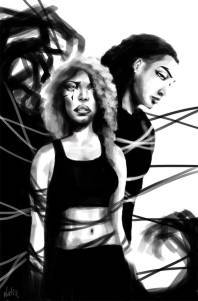 Like the genre from which it gains inspiration, Cyberpunk, Cyberfunk is a genre of Speculative Fiction centered on the transformative effects of advanced science, information technology, computers and networks (“cyber”) coupled with a breakdown or radical change in the social order. Unlike Cyberpunk, however, Cyberfunk is expressed through an Afrikan / Black lens (“funk”).
Like the genre from which it gains inspiration, Cyberpunk, Cyberfunk is a genre of Speculative Fiction centered on the transformative effects of advanced science, information technology, computers and networks (“cyber”) coupled with a breakdown or radical change in the social order. Unlike Cyberpunk, however, Cyberfunk is expressed through an Afrikan / Black lens (“funk”).
Often possessing a dark, gritty and cynical tone, Cyberfunk includes elements of Film Noir, hard-boiled Detective Fiction and postmodern deconstruction.
What might seem to be forward thinking in science fiction, in many Cyberpunk works, Afrika is a popular setting. Oddly, though, in Cyberpunk, Afrika often seems to be the one place in fiction that never gets better as time goes on. Occasionally in Cyberpunk, Afrika catches up to the rest of the world technologically, but, of course, it still doesn’t get any better. Technology is advanced, but there is still no reduction in widespread poverty; the continent still suffers from diseases the rest of the world seems to have gotten under control. Poor Afrikans…we just can’t seem to get it together no matter how advanced we are.
This is not the case in Cyberfunk, of course. At least not the case in The City – which may or may not even be set on earth, but one thing is sure, the majority of its inhabitants are of Afrikan descent and in some parts of The City, time and place are described using Afrikan languages and principles.
 Heroes are often actually antiheroes and…
Heroes are often actually antiheroes and…
Well, you’ll find out when you pick up your copy from MVMedia, or on Amazon, or Kobo, or B&N.
However you get there, I’ll see YOU in The City soon, Cityzen!
Below is a list of The City’s authors and their Cyberfunk stories.Be sure to check out my story, The Verdict, in this Blacktastic anthology.
Darkest Light – Natiq Jalil
Move – Zig Zag Claybourne
The Verdict – Balogun Ojetade
Welcome to Liberty – Gene Peterson
Collard Greens, Humming Birds and Spider Silk – Malon Edwards
Washed Pure, Washed Clean– Raydeen Graffam
Mission: Surreality – K. Ceres Wright
Glitch – Brandee Laird
Street Moon’s Revolution – Valjeanne Jeffers
Dreamer’s Recall – Jeff Carroll
The Man with no Name – Keith Gaston
The City Mole – Alan Jones
How High the Moon – B. Sharise Moore
The Score – Chanel Harry
The Runners’ Ball – Tabitha McQueen
Edge of Innocence – Ced Pharaoh
Hunter’s First Rule – Gerald Coleman
Free your Mind – Kai Leakes


September 18, 2015
The City: A Cyberfunk Jazz Session by author and publisher, Milton Davis
It began as a random thought in the middle of the day. I was sitting at my desk during lunch when words popped into my head.
‘The City. No one 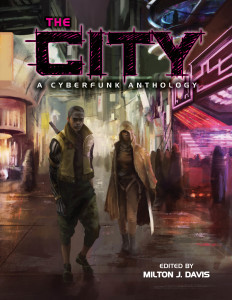 knows how it began or when it will end. No one knows how we came to be here, 20 millions souls, 1500 different species all crammed together in plascrete and biosteel. No one’s been in or out of the city in 20 centuries. Some have their theories why, some don’t care. But no matter who you are, or what you are, you have a story, don’t you? The trick is finding someone that cares to listen…’
knows how it began or when it will end. No one knows how we came to be here, 20 millions souls, 1500 different species all crammed together in plascrete and biosteel. No one’s been in or out of the city in 20 centuries. Some have their theories why, some don’t care. But no matter who you are, or what you are, you have a story, don’t you? The trick is finding someone that cares to listen…’
As I normally do I posted the statement on The State of Black Science Fiction Facebook page. What happened next is an example of why I love writing so much. A writing improv session began, with different writers adding words to the narrative and supporting those words with artwork. At some point it was inevitable, The City would become an anthology.
Balogun Ojetade (http://chroniclesofharriet.com/) gathered the thoughts then organized them into a manifesto, creating an outline of the city and it’s wide range of characters. We shared the document with everyone then put out the call. In the beginning I worked to make the stories follow a specific path, but then I decided to drop that idea. I wanted to keep the same jazz-like improvisational vibe we experienced at SOBSF. So I took the stories as they came, accepting every story as the writer submitted them. Every story. Some writers collaborated, joining the stories of their characters, some wrote stories about the same characters. The result is an anthology containing a wide variety of interesting stories that stretch the boundaries of what some people call Afrofuturism, but what we choose to call Cyberfunk.
But it doesn’t stop there. The City is a multi-sensory experience. Edison Moody and Natiq Jalil added their am azing artistic skills to the project, creating amazing images for the anthology. Otis Galloway, a DJ from the UK inspired by the improv session, created mixtapes reflecting the moods and emotion of this mysterious urban space. It’s a project unlike any I’ve worked on and it’s a project that you’ll enjoy experiencing. For the next week you’ll read about the development of The City from its ‘Cityzens,’ the artists that have brought this world to life. Get ready. The City will be available as an e-book via Amazon, Barnes and Noble (Nook) and Kobo on September 25th and as a paperback at MVmedia (www.mvmediaatl.com) and wherever books are sold by October 15th. Welcome to The City. I hope you enjoy your stay.
azing artistic skills to the project, creating amazing images for the anthology. Otis Galloway, a DJ from the UK inspired by the improv session, created mixtapes reflecting the moods and emotion of this mysterious urban space. It’s a project unlike any I’ve worked on and it’s a project that you’ll enjoy experiencing. For the next week you’ll read about the development of The City from its ‘Cityzens,’ the artists that have brought this world to life. Get ready. The City will be available as an e-book via Amazon, Barnes and Noble (Nook) and Kobo on September 25th and as a paperback at MVmedia (www.mvmediaatl.com) and wherever books are sold by October 15th. Welcome to The City. I hope you enjoy your stay.




